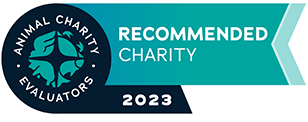In Faunalytics’ Tactics In Practice series, we offer standalone resources that delve into the research behind one popular advocacy intervention. Our research has indicated that advocates crave more summarized collections of existing research explained in a digestible format — this project is one way we aim to address this need.
These posts are not meta-analyses nor research papers. Our technique differs from a formal study in that we did not pre-register our hypotheses or use a research paper format when writing our conclusions. However, as part of creating these resources, we held interviews with advocates and experts in the field who are knowledgeable about the intervention application, a technique rare in desk research. These interviews help us contextualize the studies — sometimes the research conclusions, while empirically sound, miss a key factor that affects advocates in the real world.
Combined, the literature review and interviews will help advocates make better decisions about 1) Whether or not they should pursue a certain advocacy technique, and 2) If they’ve already chosen a certain intervention technique, how they can make it even better.
Researchers may also benefit from reading these resources. While these aren’t formal papers, seeing a summary of the current best practices may help scientists contextualize the state of their research.
Where can I read all of the Tactics In Practice?
- The Science Of Social Media Advocacy
- More to be added in the coming months
What are the guiding questions for our Tactics In Practice?
Primary questions:
- How effective is X form of advocacy?
- How can advocates maximize the impact of X form of advocacy?
Occasionally, other questions may arise about an intervention technique if they are commonly addressed in research or relevant to animal advocates. These questions may include:
- How are advocates currently using X form of advocacy?
- What are the short-term vs. long-term effects of X form of advocacy?
- How do other social movements use X form of advocacy?
Supporting questions that we consider when drawing our conclusions:
- What are the limitations of the existing research on X form of advocacy?
- How/how much do these limitations influence recommendations?
Where do we search for data?
We searched for studies in this order. Steps 5, 6, and 7 may or may not be taken, depending on the depth of information per topic.
- Faunalytics Studies
- Faunalytics Research Library
- Google Scholar
- Interview with 3+ prominent activists or experts in the field
- Follow-up interviews or emails based on activist conversation (optional)
- Conversations with other Faunalytics staff and external researchers (optional)
- Further lit review if more questions emerge during analysis (optional)
Advocates in step 4 were chosen for interviews based on their relevant experience to the topic at hand, and availability. They are often in the professional network of Faunalytics staff and are thus not intended to be, nor are likely to be, representative of the entire animal advocacy movement.
How do we search for data?
Each form of advocacy was searched in the Faunalytics Research Library with at least four synonyms. Here is an example from the first topic “Social media advocacy”:
- “Online messaging”
- “Social media”
- “Media narratives”
- “Tiktok OR Facebook OR Instagram OR Twitter OR LinkedIn”
In Google Scholar, we searched for each form of advocacy and relevant synonyms along with these phrases:
- “Animal advocacy”
- “Vegan”
- “Vegetarian”
- “Pro-animal”
- “Animal protection”
- “Animal welfare”
- “Animal rights”
What criteria do we use to select studies?
All Faunalytics Studies on the topic will be included. All studies in the Faunalytics Research Library that are relevant to the central and framing questions (below) will be included. We will determine relevance by reading the titles and, if ambiguous, the entire summary of the study in the library.
All Google Scholar studies specific to animal advocacy will be included within the first two pages per topic, assuming they are relevant. Relevance to the primary questions (listed below) will be determined based on the title and abstract. In the unlikely event that the topic reveals large amounts of relevant studies (for example, more than 20 all addressing similar questions), we will prioritize the most recent and most comprehensive studies.
Some studies about other forms of advocacy may be included if they can help contrast or illustrate relevant ideas in animal advocacy (e.g., how climate protests and animal protests may or may not differ in impact). These studies will be researched if and when relevant questions emerge in the lit review.
How do we summarize the research into digestible conclusions?
After conducting a small literature review, we summarize the findings of the relevant studies we collected, focusing on common trends and major deviations. When the findings are mixed, we will attempt to break up the studies into groups and identify key features. For example, it is possible that a tactic works in the short term but fails in the long term. We will clearly convey this nuance to the reader.
In the course of synthesizing findings, we make note of methodological choices or outcomes that may limit interpretation. In particular, we consider sample sizes, sampling methods, outcome measurement, use of methods that allow for causal inference, participant characteristics, and study location.
As always, we use a lay-friendly approach in our writing.
How do we choose topics of Tactics In Practice?
Our topics are chosen by subjectively weighing several defined criteria:
- Depth of research available
- Relevance of the topic to the animal advocacy movement
- Depth of understanding that advocates have towards the research topic (i.e. is it commonly misunderstood by advocates?)
- Potential impact of the research summary to the movement
Still have questions about this project? Please attend our office hours to talk with our research team.


